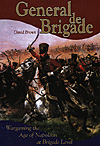 I took the opportunity of a visit from my old friend Alasdair Jamison to play-test these rules. I usually play solo. We chose the simplest scenario we knew i.e. "The Battle of Blastoff Bridge" from the book "Charge" by Brig. Peter Young and Lt. Col. Lawson.
I took the opportunity of a visit from my old friend Alasdair Jamison to play-test these rules. I usually play solo. We chose the simplest scenario we knew i.e. "The Battle of Blastoff Bridge" from the book "Charge" by Brig. Peter Young and Lt. Col. Lawson.
The terrain was set out on a 6' by 8' table and I drew the French (a mixture of Prince August, Flintlogue and Redoubt Enterprises figures). Alasdair took on the CiC of an Austrian army - almost all Essex Miniatures with one or two Mirlton of Italy. All these figures are 25mm so all ranges and move distances were doubled (the Rules were written with 15mm in mind).
We chose Brigadiers - and divided our Commands up into brigades. This worked out mainly at two battalions per brigade but the French Voltigeur Brigade had 3 battalions. We quickly made paper markers a) for the brigadiers, b) for the orders. I think a photocopiable sheet for these would be a good idea - or a printed set added to the rule book. It could go along with the pull-out quick reference sheets. Paper markers look pretty tatty after a while. The players could make card ones of their own and cover them with "fablon"; but that's an added chore.
Progression
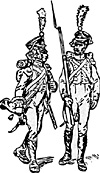 The game progressed slowly as we had to keep consulting the rules, as we had never used them before. Obviously if these rules are used a lot, calculations become swifter and modifiers known by heart and all would speed up. Neither of us liked the 1/4 and 1/2 casualties and the need for special dice to calculate this. We prefer the casualty "washer" or "cap" method, because the state of any body of troops can be seen at a glance.
The game progressed slowly as we had to keep consulting the rules, as we had never used them before. Obviously if these rules are used a lot, calculations become swifter and modifiers known by heart and all would speed up. Neither of us liked the 1/4 and 1/2 casualties and the need for special dice to calculate this. We prefer the casualty "washer" or "cap" method, because the state of any body of troops can be seen at a glance.
The preliminary orders were written, e.g. Austrian General CiC
-
Infantry Seize and hold Blastoff Bridge.
Artillery Deploy to support the infantry.
Horse Move ahead to initially dispute control of bridge and deny it to enemy until infantry able to come up.
Jäger Move ahead with horse to support initial disputation of the bridge.
CiC rating Average. (The French CiC rolled Average too).
General Synopsis
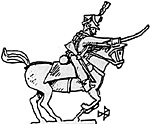 Both forces made for the bridge in the fastest mode possible. Two Austrian cavalry units (i.e. a brigade) got over the bridge and formed up as a French cavalry brigade swung right around their own advancing troops to face them
Both forces made for the bridge in the fastest mode possible. Two Austrian cavalry units (i.e. a brigade) got over the bridge and formed up as a French cavalry brigade swung right around their own advancing troops to face them
The French artillery, in the centre of the force didn't deploy quickly enough to catch the Austrian cavalry - and anyway - didn't want to accidentally damage the bridge which was the main objective. I soloed from here as Alasdair had to leave. Here the rules took over as the two opposing bodies of cavalry clashed. Due to morale rolls and better dice for the French both Austrian units routed away into the river behind them! They were additionally hit in the flank by a body of French lancers following up.
The Jäger lined their side of the river bank and exchanged fire with the voltigeurs opposing them. There was little effective fire on both sides, the rules seemed logical here, dispersed troops firing into each other didn't have much impact with similar weapons, unlike the British Rifles in history.
An Austrian Infantry brigade - one line unit, one grenadier - crossed the bridge and exchanged fire with their opposite French brigade. Whilst this was in progress a French battery opened up on their flank and did the valiant Austrians considerable damage. They were also aware of their cavalry brigade rushing into the river behind them. The bridge was blocked with more Austrian infantry trying to get into action over it.
The second Austrian cavalry brigade - a unit of lancers and another of dragoons - was stymied by their own troops on the bridge. The Austrian artillery, at the tail of the column unlimbered and tried to come into Action Left but were also masked by their own routing cavalry.
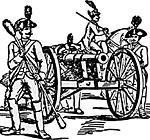 The Austrian CiC decided then to switch tactics and the rearmost infantry brigade wheeled into line on their side of the bridge, conforming to the artillery. The remaining cavalry brigade turned to their right and tried to infiltrate behind the farm, through a hay field and behind a plantation to come up on the right of their forces, effectively putting them out of the battle.
The Austrian CiC decided then to switch tactics and the rearmost infantry brigade wheeled into line on their side of the bridge, conforming to the artillery. The remaining cavalry brigade turned to their right and tried to infiltrate behind the farm, through a hay field and behind a plantation to come up on the right of their forces, effectively putting them out of the battle.
The Austrian infantry on the bridge continued on over it in order to protect the bridgehead for the other brigade on their left to be able to withdraw. Unfortunately for them their left flank was disrupted by the fleeing dragoons and their right flank enfiladed by another French battery which had not moved for some time! The Austrian brigade that the brave line regiment was trying to protect was meleeing with their opponents by this time and finding it very difficult to disengage.
Moves then ran out and darkness closed down this messy situation. The French were definitely in the ascendancy at the finish but the Austrians still held the other bank of the river in reasonable strength. They were holding the river line and the bridge was still in their possession.
Take Over
These are interesting rules and quite "take over" the game so the player(s) are not in God-like control or anything like it. I didn't like the 1/4 and 1/2 casualties so I shall use my own casualty mechanisms while keeping the rest.
Well worth buying these rules which are well presented. Glazed paper is used - which doesn't wear well if the rules are much used - too many coffee and beer splashes and biscuit crumbs stick to glazed paper. I would suggest "ordinary" unglazed is used instead.
Thanks to David Brown for writing them and Partizan Press for publishing them (816-818, London Road, Leigh-on-Sea, Essex, SS9 3NH. Tel. 01702 73986)
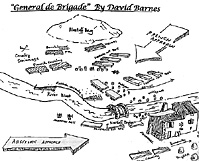
Back to Table of Contents -- Lone Warrior #118
Back to Lone Warrior List of Issues
Back to MagWeb Magazine List
© Copyright 1997 by Solo Wargamers Association.
This article appears in MagWeb (Magazine Web) on the Internet World Wide Web.
Other military history articles and gaming articles are available at http://www.magweb.com
